How to Get Your First Customer
A practical guide for founders on how to get their first customers by doing unscalable things, learning sales, managing a pipeline, charging early, and working backwards from sales goals.
Many founders incorrectly believe that all you need to succeed is a good product, and growth will take care of itself. This is not the case. The truth is that good products are very rarely built in isolation, but together with your customers. As a result, your product isn't actually that good when you show it to your first customers.
Startups don't take off by themselves. Startups take off because founders make them take off. You have to manually recruit your customers. It's not enough to push a button on an advertising network.
This is uncomfortable, and founders continuously find many ways to avoid doing it. The most common way is believing that you can recruit people by just writing more code or doing more work on your machine.
The Startup Curve
Most companies go through something called the startup curve. Here's how it goes:
First, you launch. These days, most companies don't launch on TechCrunch but probably on Product Hunt or Hacker News. The launch energy eventually starts wearing off as early adopters look for something new. If you don't have instant high retention (nobody does), then you'll enter the "trough of sorrow."
This can take a long time, and many companies die during this stage. They just give up and don't move fast enough with testing new things. Some startups do move fast enough and release new improvements. They'll listen to users and improve. Many still don't get anywhere further and become victims of the "crash of ineptitude."
It's the founders who stay the course and don't give up that reach the "wiggles of false hope" and eventually the promised land of product-market fit.
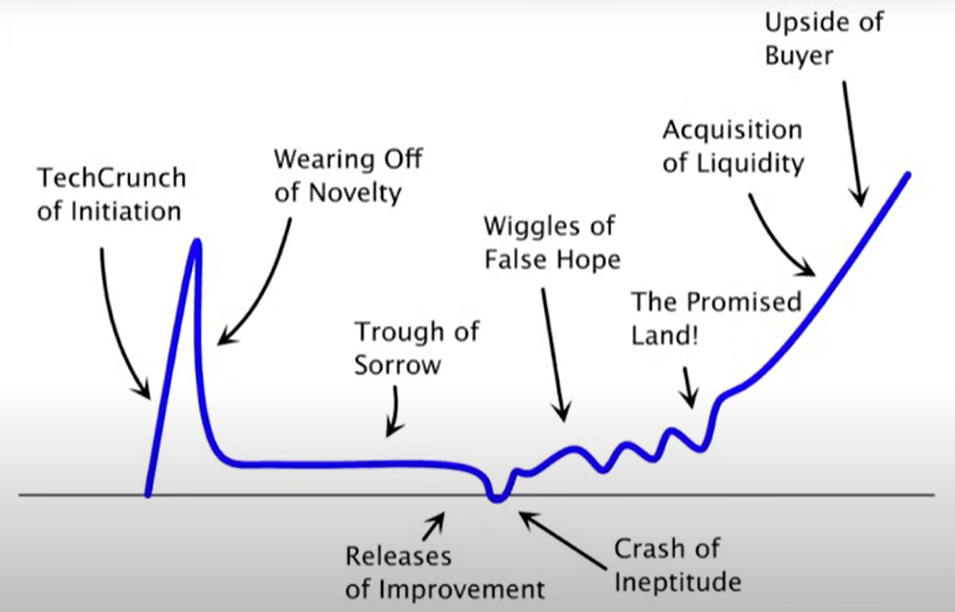
The learning we draw from the startup curve is that every moment in the early days of startups, the founders are the ones that make the difference between success and failure. If you're in the wrong market, it's the founders who switch to a new one. If you don't know how to do sales, it's the founders who learn.
You have to really want it. Otherwise, this won't work.
Why Founders Should Learn Sales
You should learn how to do sales because:
-
You need to know your customer - Talking to customers and sales are effectively different sides of the same coin. The same reasons founders can't understand what to build (they don't understand the problem) apply to sales.
-
It gives you control over your destiny - Just like you can't outsource engineering, sales has to be part of the DNA of the founders.
-
Don't hire a sales team until you know how to do sales yourself - Only then will you know what good looks like.
-
You can learn it - If you don't know how to sell, don't worry. It's probably the easiest job to learn in a startup. If you know the problem you're solving, if you know your product intimately, if you know the market, you are an expert in the eyes of the customer.
-
A love for solving customer problems is infectious - If you're really passionate about solving this problem, they will be able to tell.
Here are some examples of founders who took on the sales job and learned to get really good at it: Tony from DoorDash, Mathilde from Front, Tracy from PlanGrid, and Steve Jobs.
How to Write a Great Sales Email
Let's look at an example from the Brex founders, Pedro and Henrique. When Brex was in YC in Winter 2017, they recruited their first 10 customers directly from the YC batch. They asked themselves what the minimum product would look like that they could build to be useful to other startups, then went straight into signing up those customers.
The first version was very simple—customers just had a virtual credit card. Enrique from Brex actively onboarded every customer himself. They could have waited until they had a full-blown product, website, mobile app, but they decided to get going when they had something that was really useful.
Here's the email they sent:
"Hey guys, we're opening up our beta for Winter 17 batch friends with 10 spots for beta users. Brex is a corporate credit card focused on technology companies. We don't require a personal guarantee and can underwrite startups who just got started. How much does it cost? It's free. The merchants are paying us, so there's zero annual fees."
This email worked, but it's probably a little too long. Here's how to write a great sales email:
-
Keep it short - Max 6-8 sentences. People don't have time to read long emails.
-
Use clear language - No jargon, no buzzwords. Just say exactly what you do and how it works.
-
Address the problem - Address the problem that the potential customer is having.
-
Use plain text - No HTML formatting. Write it like you would to a friend.
-
Say you're the founder - Many people forget to do this. Describe why you and your team are impressive. Include social proof and remember to show, not tell. Don't say you're an expert—if you're in the incubator or worked at impressive companies, include that.
-
Include your website - Keep it simple. Screenshots of your product and bullet points about what it does. Sometimes a short video or GIF works.
-
Ask for a call - There needs to be a call to action.
The Sales Funnel
The concept of sales funnels is really quite easy. I think people get confused by the language salespeople use, so I'll simplify it.
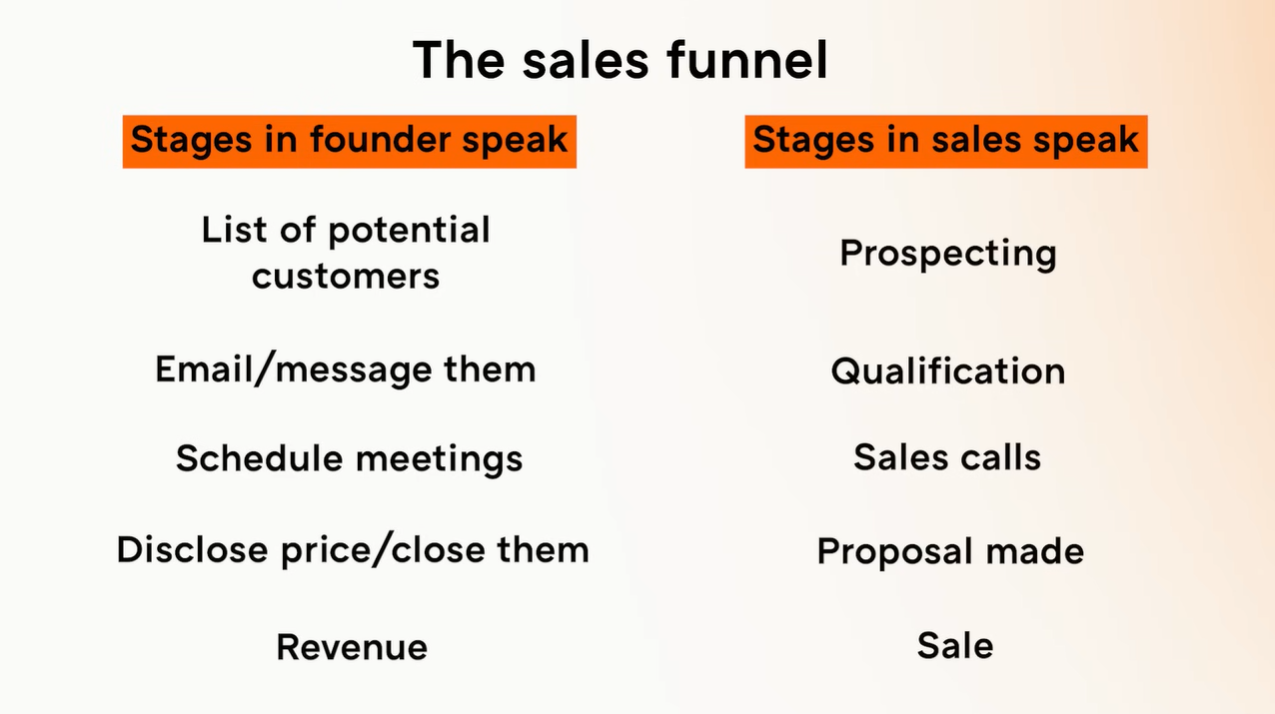
Here's the process:
-
Make a list of customers you plan to reach out to (in sales, this is called prospecting or lead generation)
-
Send them an email or LinkedIn message
-
Schedule and run a demo or meeting from the response
-
Talk pricing
-
Close them as a customer
-
Onboard them - This is crucial. If you forget this step, you'll have lots of churn because people don't actually know how to use your product.
You should track some basic data about your prospects:

Start simple with columns for industry, company, title, name, email, maybe LinkedIn. This could be enough to start with. A lot of CRM software comes with these categories, so it's a pretty good idea to use a simple CRM software.
Who Should You Target?
Here's my most important advice when it comes to sales: your first customers should be your easiest. This is not the time to bite off the hardest one. Focus on the easiest ones.
You should try to make the sales process as easy for you as possible. Startups don't really have time to chase every lead. You don't have to pick all of them. You're so early, you can pick only the ones that are most likely to close.
The best way to do this is to have a big pipeline (a lot of people you're emailing are potential customers), and then as you're getting responses and meetings, start prioritizing those who are most likely to close. You can probably tell from their answers to your qualifying questions during the sales call.
Avoid those who are moving slow, and don't be afraid of letting customers go. If someone is dragging you along for two or three calls, you can always say, "It's been great getting to know you, and I've learned a lot, but we should talk again in six months." That's totally fine to say.
Sell to your network - Selling to people you know is going to be easier than selling to strangers.
Sell to startups - This is the easiest category. Bigger companies have more bureaucracy, more processes, they even have a specific department that is in charge of negotiating with you. Startups don't have any of these things because they don't have time to create them. Startups have short decision-making lines. You can often find the decision maker right away.
Most people are not early adopters - The reason you have to send hundreds of emails is not that most people get really upset. Most people just archive the email. They're not going to try a new product that comes through LinkedIn or email. They might not be the people that try new products at all in their career. That's most people.
Some people are early adopters. I remember being one of those people when I worked at Airbnb. I would love when founders emailed me with new products. I am an early adopter. I love trying new things.
For every outbound email to an average company, you will most likely reach someone who is not an early adopter. To reach early adopters, you just have to send more outbound messages. You don't have time to convince anybody to become an early adopter. You have to find early adopters and just go for them.
Why You Need to Charge
It's attractive for you as a founder and for your company to offer your product for free, offer free trials, or unpaid pilots. However, if you don't charge your customers, they are not a customer and you don't have a company.
Customers paying you money is a great sign that you're providing them real value. You should resist the fear of getting a "no" because of price. If they don't want to pay, and you learn this during the qualification process in the first call, that's a great sign that you should move on to the next customer.
No free trials - For B2B, offer a money-back guarantee or the ability to opt out from the annual contract. For consumer, ask for the credit card upfront.
Increase your price until customers are complaining but still paying. That's the right way to go.
Working Backwards from Your Goal
This is the thing that most founders get wrong. I've seen it many times.
To work your way backwards from a goal of say, two signed customers, you have to understand that each step in the sales funnel is going to have a drop-off. When you haven't started sales yet, you don't know what these drop-off percentages are.
As you're sending these outbound emails, you need to take notes and start tracking all of these conversions.


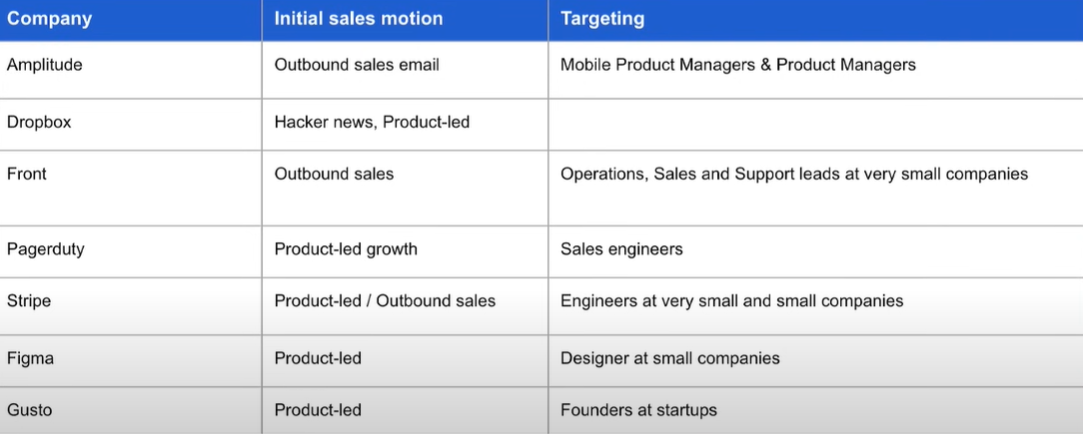
In this example, I'm sending 500 outreach emails or LinkedIn messages. I have a 50% open rate, so 250 people will open the email. Five percent will respond, that's about 20 potential customers. 50% of those will convert to demo from the response, which means I'm doing 10 demos. But I'm not that good at doing demos—only two end up becoming customers from the demos. That's 20%.
I bet most of you don't even track this data, but you should. If you track this data, you will have some idea of how long it will take to get to 10 paying customers. If you don't track this, it's very hard for someone to give you feedback on what's working and not working.
My advice is to use a simple sales CRM software that tracks these conversion rates automatically.
Let's look at a second example. In this example, I'm sending 100 outreach emails. It feels like a lot to me. If I keep the conversion rates constant from the previous example, I actually end up with zero customers.
The conclusion founders draw after this is that "sales is not working for me, and I should just do marketing or SEO or something else." This is simply wrong. You don't have the data to make that call. You did not do enough outreach to actually get to correct conversion rate percentages in your sales funnel.
The answer here is you sent too few emails. You don't have the data. You can't draw the conclusion that sales is not working. This is the mistake that founders do over and over again.
The Founder Should Do the Demos
Your goal is to close your first customers. You want to ask a lot of questions upfront in the demos. The founders should do the demos because you are the one knowing the product and you know the customer pain points.
Here are three example emails that led to customers:
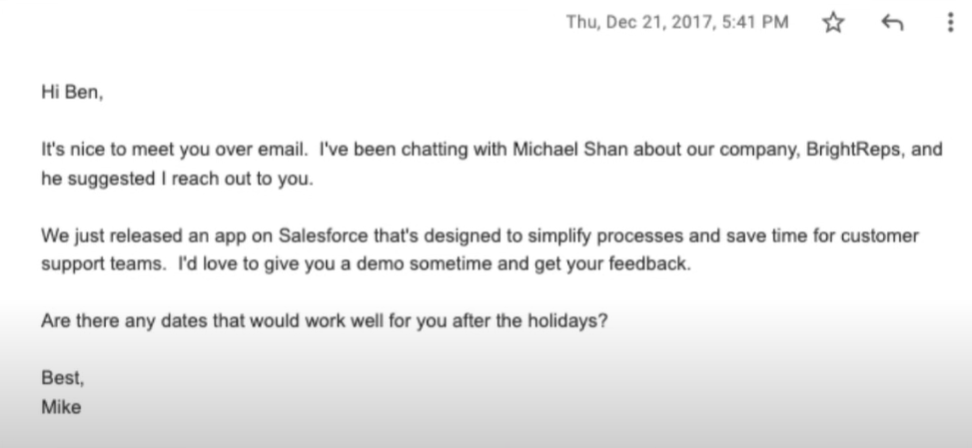
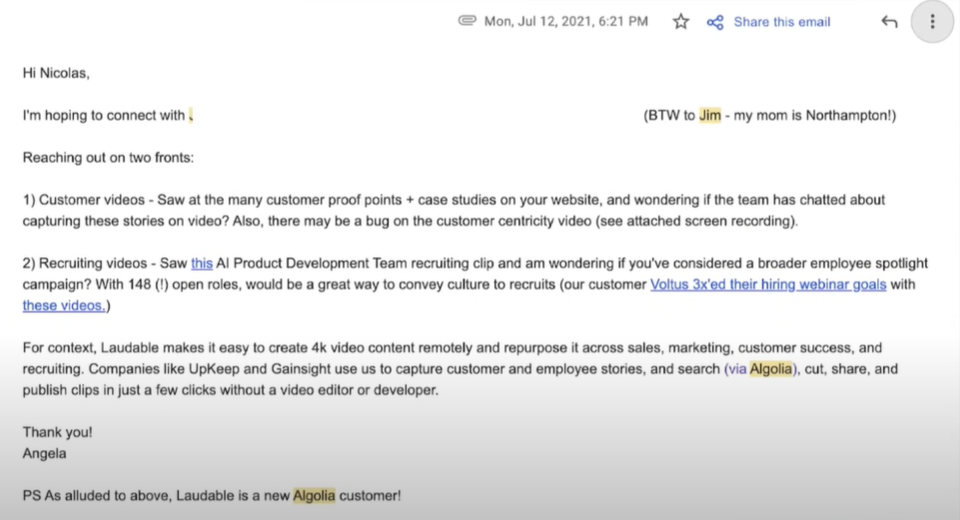
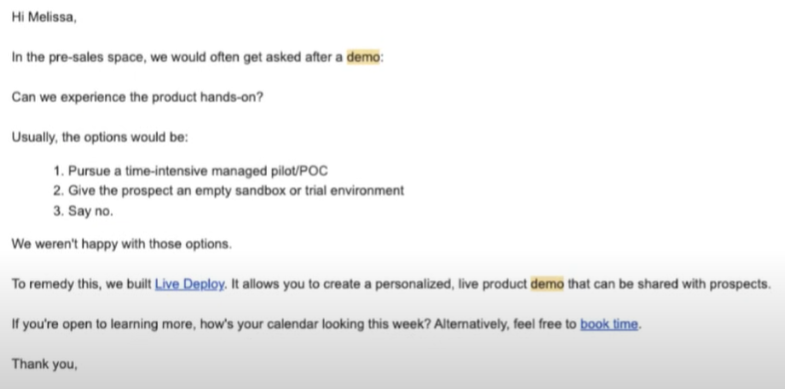
Most Common Sales Mistakes
-
Founders don't send enough outreach - Because they don't work backwards from the goal
-
Believing that something else besides sales will solve your sales problem - Outsourcing sales is wrong. You should do it yourself.
-
Not qualifying your customers enough in the first call
Tools and Resources
Here are some tools I recommend:

I recommend Apollo.io, Close.com (formerly called Close.io), Pipedrive, or Hunter.io. These are great tools you can use either as a simple sales CRM or to get contacts from LinkedIn.
For books, I recommend "Founding Sales" and the Lenny's Newsletter.
Other Ways to Grow
There are other ways you can grow as a startup, but the truth I've learned is that even if you end up with growth channels like word of mouth, Google search, referrals, Facebook advertising, that's not how companies start.
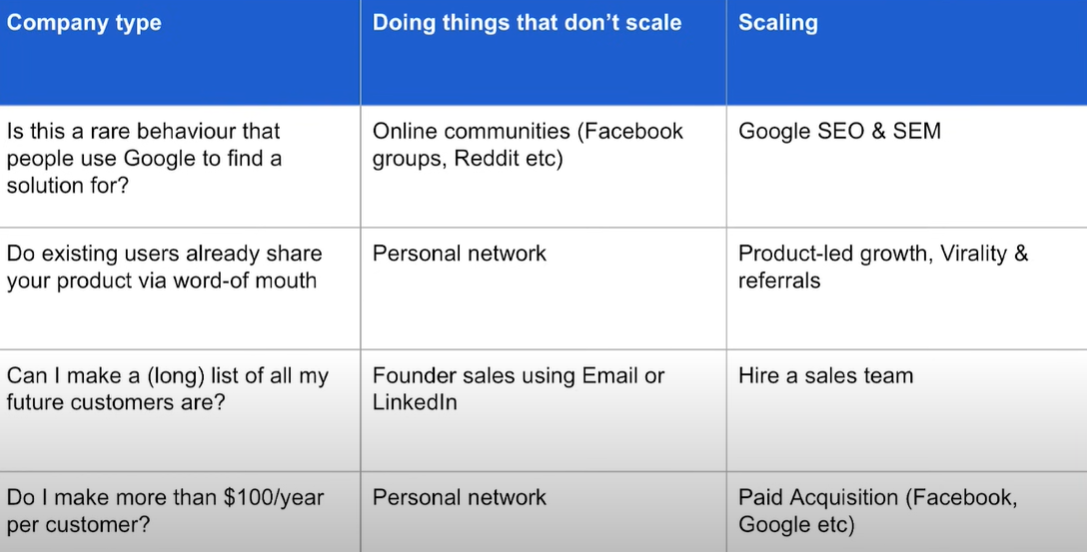
Airbnb didn't start by running Google SEM or SEO. The referral program did not bring in the first 2,000 customers. They did things that didn't scale, and they looked different than what they do at scale.
A lot of companies are jumping straight into scalable growth channels—the channels they've heard work (which is true at scale), but that's not the same thing as when you're getting started.
If you're trying to go after SEM (search engine marketing), it's going to be expensive because there's competition. If you're going after SEO, it's going to take a long time. If your growth is product-led or virality/referrals, then personal networks and selling through your personal network to your co-workers is the way to get started.
If you're doing sales, you should be doing sales. It doesn't change very much. Early-stage sales to large sales basically means all the things I just described done by 100 people in a sales team with more automation, more tools, more metrics, but it's the same thing.
If you're doing online marketing, it's not usually how most people start. Why? Because you can't really easily talk to people. You can't learn from users if the first thousand or first hundred customers are brought in through Google and Facebook. Those people are not the kind of people you can easily get on a 30-minute phone call with.
Summary
The key insight is that getting your first customers is not about building the perfect product or finding the right growth hack. It's about doing the uncomfortable work of manually recruiting customers, learning to sell, and being willing to do things that don't scale.
The biggest mistakes founders make are not doing enough outreach, believing that something else besides sales will solve their problems, outsourcing sales too early, and not qualifying customers properly.
Remember: startups don't take off by themselves. Founders make them take off.
Notes
[1] The phrase "Do things that don't scale" is originally from Paul Graham's iconic essay. It's a guiding YC principle that early founders should manually hustle to get users, rather than prematurely trying to automate growth.
[2] The idea that founders must learn to sell comes from YC's repeated emphasis that you can't outsource core startup activities early on. As Sam Altman and others have put it: "If you can't sell your own product, no one else can."
[3] Sales tactics like founder-led outreach, short plain-text cold emails, and personalized follow-ups reflect best practices from early-stage YC companies and insights shared in talks by founders of companies like Brex, Segment, and Atrato.
[4] The sales funnel framework, pipeline management tips, and emphasis on focusing only on early adopters are consistent with teachings from YC Sales School (especially by Tyler Bosmeny, former YC visiting partner and CEO of Clever).
[5] Charging early and not offering free trials is common YC advice—particularly in B2B. The rule of thumb: if they won't pay, they're not really your customer. It's echoed in advice from founders like Patrick McKenzie and Garry Tan.
[6] The concept of working backwards from your goal—understanding conversion rates, modeling your outreach targets, and tracking the math of sales—is foundational to effective outbound strategy and was popularized in YC startup sales templates.
[7] The tools and books referenced at the end of the post are standard in modern SaaS and founder sales playbooks. Notable recommended reads include The Mom Test (for customer validation), Predictable Revenue, and SPIN Selling.